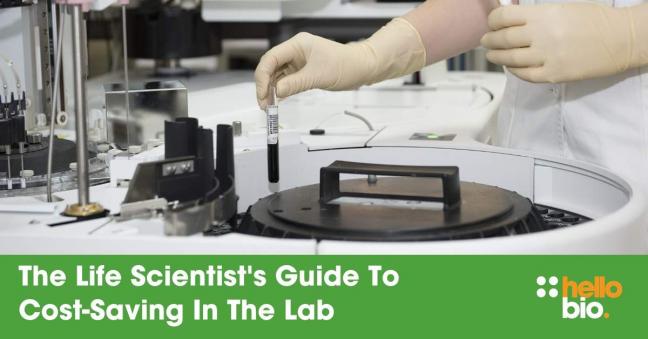The Life Scientist's Guide To Cost-Saving In The Lab
One of the biggest challenges for life scientists is working within budgets to make your grants and funding go further. In this Life Scientist's Guide To Cost-Saving In The Lab, neuroscience PhD student Karolina Farrell from UCL shares her top tips for cutting costs (not corners) in the lab. We also put the question of cost-saving out to our Twitter community, and got some fantastic tips which we’ve included alongside Karolina’s great advice. If you have any more cost-saving tips to share with your fellow scientists, comment below!
Before buying anything, ask yourself three questions
When it comes to cost-saving, thinking ahead and looking at where you can be resourceful is key. When you’re writing your lab shopping list, start by asking yourself the following three questions.
Do I really need it?
When you’re planning for your experiments, work out what expenses are absolutely necessary, where both quality and quantity cannot be compromised. This will depend on the kind of lab work you do, and can vary greatly between different labs.
Nina Lichtenberg @NTlichten on Twitter says:
“Planning! Part of this is aliquotting the smallest working volumes possible and storing everything you can (i.e. antibody, aavs, enzyme, drugs too!). Get in touch with the manufacturer if you're unsure about longevity.”

Can I substitute it for something similar?
You never know, you might be able to buy a commercial product that has the same function as your lab equipment for a cheaper price. For example, a sous vide water heater can replace a standard laboratory water bath – and it can even be operated wirelessly.
Rachelle Balez @chellebalez on Twitter says:
“When using expensive growth factors, even if the aliquot looks empty, I’ll save it and then spin a bunch down and combine the dregs. Also, careful planning of experiments, using non-filter pipette tips whenever possible or vacuum for removing media and having a DIY attitude are all small things that can help a lot.”

Can I make it myself?
If you do a lot of bench work, you will probably be familiar with making up your own buffers, media and gels. Some labs prefer to buy in pre-made buffers and gels, but it’s a lot cheaper to buy the reagents and make them yourself, although it requires investing a bit of your time. Depending on your lab’s usage, you may find it cheaper to make your own rather than buying in pre-made – and it saves on packaging in the long-run too.
If you need specialist equipment, you may find that you can make your own by combining cheaper items. For example, you can make your own custom surgery tools or an aspirator (given you have access to a vacuum line). If you have access to a 3D printer, you can design and make parts for your ongoing projects, whether it’s part of your rig or your custom microscope. Other times, old parts that are no longer in use can be repurposed for your new project.
Soraya M @s_meffy on Twitter says:
“3D printing of various holders/custom small pieces has been fairly handy and cheap if you have one that’s accessible.”

Of course, you will have to weigh up how much time and effort are needed to make your own parts, as well as whether your finished product will be sophisticated enough for its required purpose. There may be times where you can make parts that ultimately don’t work or aren’t good enough for the job, and it’s important to realise that you may be able to save yourself a lot of time (and frustration!) by just buying the item.
The pros and cons of making it yourself...
Pros
- Custom to you and your desired function
- Can be much, much cheaper than buying
- Can be made quickly, perhaps faster than it would take to buy and deliver
- Gives you the flexibility to choose material, specifications, etc.
Cons
- May not be good quality / may break – it will require testing before use
- May take up too much of your time and delay your ongoing work
Buying
If you don’t need many
If you decide there’s a specific product that you need and cannot substitute, first ask how much or how many of it you need. If it’s a small amount, you could try asking collaborators or neighbouring labs if they have any that they could gift you. This way you can also benefit from their knowledge of using it! If not, another tactic is to make contact with a sales representative for the company (or companies) that you’re interested in buying from, and ask for a sample (this particularly applies to items sold in bulk). They may not be able to give you any samples but if they can, there are two important pros. Firstly, you can check that the product meets your needs before buying in bulk, and secondly, you may find that the sample is enough to do the job!
If you do need many
If you know that you will need a lot of something, then buying bulk is usually cheaper per item and saves on potential delivery costs. If you aren’t sure it’s the correct product, you can always ask for a sample to check it will work for you. Always double check that the price for a bulk order is cheaper than buying several smaller orders – sometimes catalog ‘deals’ aren’t really deals at all – and you can always ask for a quote to try and get a discount on bulk orders.
Steve Roome, CEO, Hello Bio:
“Our advice would be to always get quotes from several different suppliers, along with a product specification for each quote, to make sure that your quotes are comparable. You need to make sure that you are not compromising quality if you opt for the cheapest quote, so double check things like purity, or formulation, to make sure it is what you need. Once you have a quote that you like, just take a little time to evaluate the supplier too (if they are a new one). Product publications, colleague recommendations and product reviews should all reassure you that by cutting costs, you are not cutting corners.”
Brittany Berdy @BerdyAndTheBees on Twitter:
“Something that I do when it comes to single-use plastic ware is to work with your sales representatives. Sometimes there are sales where if you buy 1 case you get another half off, or buy 4 get one free. If there are things you KNOW you go through constantly, buy in bulk.”

Investing in good equipment
If you’re looking to invest in something expensive and branded (e.g. a new set of Gilsons or three) then you can ask for quotes from different sales companies. Make sure you mention if you’re getting a better deal from another company. At this point, some sales reps offer additional discounts to beat their competitors, or they can throw in free stuff with the order. The drawback is that it can take a while going back and forth between different companies, but if you’re investing lots of money in something, it can really help to ensure you get the best deal. One more issue is that some sales reps are happy to talk discounts only once they’ve met you in person and have the chance to pitch various products to you, which can end up taking up precious experimental time.
Storing materials properly
To reduce wastage and save money, ensure that any materials or biological products you purchase are properly stored according to the manufacturer / supplier instructions. Keep a lab inventory, with shelf life, and special instructions (protect from light, freeze upon receipt etc) - this will help you to plan your experiments, reduce wastage and minimise costly mistakes!
James Flanaghan, Head of Product Management, Hello Bio:
“When using biochemicals, or perishable reagents, my advice would be to carefully read all storage and handling instructions as soon as you receive your product from the supplier - this helps to minimise errors and wastage - you don’t want to have to throw away your precious enzyme inhibitor, receptor ligand, or fluorescent tool because you left it out on the bench instead of storing it in the freezer.“
Consumables: reduce, reuse, recycle, repurpose
Depending on your lab, you may find that you go through a lot of consumables: pipette tips, Eppendorfs and Falcon tubes are the most common culprits here. Of course, the easiest way to cut costs (and most environmentally-friendly) is to reduce your usage. This is more about increasing efficiency in the lab, and mostly comes with experience in lab protocols.
You can also consider whether you need sterile consumables, which are often more expensive (especially if individually wrapped). If not, you might consider washing, sterilising and reusing consumables. Some items, such as pipette boxes, can be recycled by the company in exchange for discounts, or refills can be bought at cheaper prices. Otherwise, they can be used for another purpose, e.g. pipette boxes can be used as surgery tool boxes, as they can survive quite a few rounds of autoclaving without degrading.
There were a lot of tips from our Twitter community on this:
Britt Berning @NeuroBritt:
“I'm mindful of churning through gloves. Yeah they're relatively cheap but a pile of gloves in my bin makes me feel wasteful. If sterility is essential, change the gloves. If I've barely touched anything before needing to remove my gloves, I'll leave them on my bench for later. Also, reusing diluted antibodies for westerns saves so much time and reagent! You can also save and reuse the primary for free-floating immuno (just store at 4 degrees).”
Rachelle Balez @chellebalez:
“I try to use wash and autoclavable glass bottles to store media aliquots and solutions rather than falcon tubes... helps save $$$ on plastic and the environment.”
Natalie Guthrie @NeuronalNat:
“I will save reagents where possible, if stored correctly some antibodies can be reused say for westerns. Or I will make the conscious choice to do one big immuno run instead of multiple, saving reagents and time.”

General maintenance to cut costs in the long-term
Finally, taking care of your equipment will mean that you keep it working optimally for longer. Dirty or carelessly handled tools can become damaged and ultimately end up unusable, which means that you need to fork out to repair it, or buy another one. This can happen at inconvenient times as well – you may find that you needed that tool to get something time-sensitive done, and buying a new one may take days or even weeks. If you share equipment with other people, it’s important to make sure that everyone uses it correctly, and this usually means training people to use it the same way that you do.
In summary
Overall, there are many ways to cut costs in the lab. Most require some forethought, so planning in advance is essential to reduce costs and keep the lab running smoothly. Asking yourself the three questions: whether you really need a product, and then whether you can substitute or make it yourself is the first line of defence against unexpected lab costs. If you do need a specific product, asking for samples and getting quotes from suppliers can help you to evade the dreaded full-price listed on their website. Spending on consumables can be limited by the 3Rs (reduce, reuse, recycle), but items can also be repurposed to prevent waste and future costs. Finally, maintaining clean, operational equipment is vital to make sure you don’t have to face the costs of repair or replacement in the future.
Karolina Farrell (@KarolinaFarrell) is a PhD student in Dr Aman Saleem’s lab in the Institute of Behavioural Neuroscience, UCL. Her research focuses on the role of midbrain dopaminergic neurons during goal-directed navigation. Prior to starting her PhD, she worked as a technician with lab managerial duties at the Sainsbury Wellcome Centre, UCL.
__________________________________
Looking for more ways to cut costs in your lab without cutting corners?
As a team, we’re always looking at our prices. It may sound ‘salesy’ but our genuine aim is to supply high quality life science tools at prices so low that as many researchers as possible will be able to afford them.
‘Half price’ biochemicals & reagents
If you’re trying to save money on biochemicals and reagents, it’s definitely worth looking at our range. If you use agonists, antagonists, inhibitors, activators, antibodies and fluorescent tools, our products are up to half the price of other suppliers (you can see a price comparison with other suppliers here).
You can use our Quick Multi-Search Tool to search for lots of products in one go, and the range includes:
- Enzyme inhibitors and activators
- Chemogenetic tools
- Ion channel modulators
- GPCR ligands
- Signaling tools
And there are other ways we can help you cut costs too…
Free sample program
We run monthly free offers to our e-newsletter subscribers, and welcome free trial sample requests from researchers wanting to try our products out. If you want to find out more, sign up here or contact us with your request.
Early Career Scientist Grants
Every month we award a $500 early career scientist grant. It’s really easy to apply, click below to find out more:
Consider buying in bulk
Despite our already low prices, we offer generous bulk discounts and a custom synthesis service, which can give big cost savings if you are looking for large quantities. Just contact us to find out more.
---
Please share your own cost-saving tips - send us a message on Twitter @hello_bio or email hello@hellobio.com. We’d love to hear from you!















